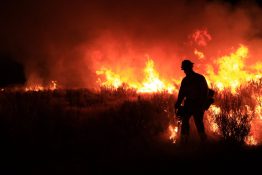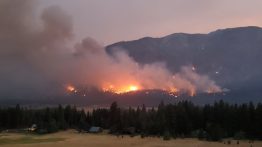Firefighters have reported that Western wildfires are starting earlier in the morning and dying down later at night, hampering their ability to recover and regroup before the next day’s flareup. A study by University of Washington and U.S. Forest Service scientists shows why: The drying power of nighttime air over much of the Western U.S. has increased dramatically in the past 40 years.
Read more at UW News »New report: State of the science on western wildfires, forests and climate change
Exceptionally hot and dry weather this summer has fueled dozens of wildfires across the western U.S., spewing smoke across the country and threatening to register yet another record-breaking year. More than a century of fire exclusion has created dense forests packed with excess trees and brush that ignite and spread fires quickly under increasingly warm and dry conditions. Scientists largely agree that reducing these fuels is needed to make our forests and surrounding communities more resilient to wildfires and climate change.
Read more at UW News »Bigger and worse wildfires? UW fire experts weigh in
2020 was a memorable year for wildfires. Images of burning forests appeared everywhere on social media and attention-grabbing headlines dominated news cycles all over the world. Heading into the 2021 fire season, two big questions loom in everyone’s minds, so we checked in with some fire experts at UW Environment to ask: Are fires getting worse over time? If so, what compounding factors are in place?
Read more »Timing is everything: ShakeAlert comes to Washington May 4
It could happen any time, any day. Multiple seismometers — scientific instruments that measure ground motion — detect a 7.0 magnitude earthquake in Washington, Oregon or California. Seismic waves move fast, but seismometers move faster: The data zips from seismometer to processing center at the speed of light (670,616,629 mph), where algorithms calculate the area and intensity of shaking and sound an emergency warning to phones moments before shaking arrives: Drop.
Read more »UW launches GeoHazards Initiative; names Paros Chair in Seismology and GeoHazards
Leveraging the tectonic laboratory of the Cascadia subduction zone, the University of Washington today announced a new effort to best understand how to study and live with the threats of earthquakes, tsunamis, volcanos, landslides and other seismic hazards. Dubbed the GeoHazards Initiative, the interdisciplinary work aims to develop and promote the adoption of early detection systems both on land and at sea to help prevent the loss of human life and property.
Read more at UW News »





